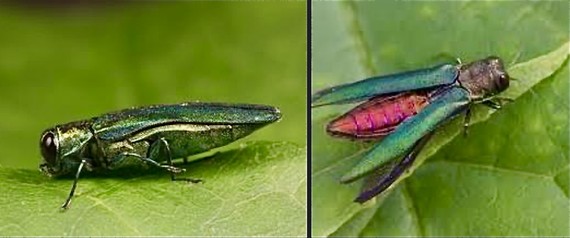Temporary quarantine adopted in Washington County to slow the spread of emerald ash borer (EAB)
The temporary quarantine prohibits tree materials from all plant parts of ash, olive, and the white fringe tree, from movement outside Washington County.
In response to the discovery of emerald ash borer (EAB) in Oregon, the Oregon Department of Agriculture (ODA) has adopted a temporary EAB quarantine as per Oregon Administrative Rule (OAR 603-052-0135), limiting the movement of ash, olive, and white fringe tree materials from Washington County. The purpose of the quarantine is to slow the spread of EAB through the restricted movement of tree materials to unaffected locations in the state. EAB is now considered the most destructive forest pest in North America, killing hundreds of millions of ash trees. This temporary quarantine will remain in effect until May 16, 2023. As more data becomes available, ODA will evaluate future quarantine parameters.

ODA confirmed EAB in several ash trees in Forest Grove in June 2022, the first confirmed sighting on the West Coast. So far, the state has only detected EAB within the city limits of Forest Grove in Washington County. The small, metallic-green beetle is native to Asia. Its larvae burrow into the bark of ash trees, causing canopy dieback and ultimately, tree death. The 1/2 inch beetle is often challenging to detect, especially in newly infested trees. Signs of infestation include thinning and yellowing leaves, bark splitting, D-shaped holes in the tree bark, and basal shoots.
The Washington County EAB quarantine restricts the movement of several tree materials including but not limited to logs, green lumber, nursery stock, scion wood, bud wood, chips, mulch, stumps, roots, branches, and firewood of hardwood species.
ODA is establishing several processing and disposal resources in the area to limit the movement of ash, olive, and the white fringe tree materials to within the quarantine area. For a list of disposal sites, and more information on EAB, please visit: ODA.direct/EAB.
There are currently no export exceptions available for nurseries located in Washington County, although this may change when the temporary quarantine ends. If you are not in Washington County and plan to ship any trees, rootstock, or firewood from ash, fringe tree, or olive trees, please contact your ODA Nursery Inspector so that you can be prepared for any additional requirements or documents.
Link to identify your Nursery Inspector: click here
Link to view the Oregon Administration Rule for the temporary quarantine: click here
The following states have quarantines against EAB and may require additional documents from the ODA to confirm you are shipping from an uninfested county:
Arkansas, California, Connecticut, Iowa, Louisiana, Maine, Minnesota, Mississippi, Montana, New Hampshire, North Dakota, Oklahoma, Rhode Island, South Dakota, and Utah
To receive email updates from ODA about EAB please subscribe at ODA.FYI/subscribe.
La cuarentena temporal prohíbe el traslado fuera del condado de Washington de materiales arbóreos de todas las partes de la planta del fresno, el olivo y el laurel de nieve.
En respuesta al descubrimiento del escarabajo barrenador esmeralda del fresno (BEF), el Departamento de Agricultura de Oregon (ODA, por sus siglas en inglés) ha adoptado una cuarentena temporal del BEF según la Regla Administrativa de Oregon (OAR 603- 052-0135), limitando el movimiento de materiales de fresnos, olivos y laurel de nieve del condado de Washington. El objetivo de la cuarentena es reducir la velocidad de la propagación del BEF mediante la restricción del traslado de materiales arbóreos a lugares no afectados del estado. El BEF se considera actualmente la plaga forestal más destructiva de Norteamérica, ya que ha matado a cientos de millones de fresnos. Esta cuarentena temporal permanecerá en vigor hasta el 16 de mayo de 2023. A medida que se disponga de más datos, el ODA evaluará los futuros parámetros de cuarentena.
 El ODA confirmó la presencia del BEF en varios fresnos de Forest Grove en junio de 2022, el primer avistamiento confirmado en la costa oeste. Hasta ahora, el estado solo ha detectado el BEF dentro de los límites de la ciudad de Forest Grove, en el condado de Washington. Este pequeño escarabajo de color verde metálico es originario de Asia. Sus larvas excavan en la corteza de los fresnos, provocando la muerte de las copas y, en última instancia, la muerte del árbol. El escarabajo de ½ pulgada suele ser difícil de detectar, sobre todo en árboles recién infestados. Entre los signos de infestación se incluyen que las hojas se vuelven más delgadas y amarillas, el agrietamiento de la corteza, los agujeros en forma de D en la corteza del árbol y los brotes basales.
La cuarentena del BEF del condado de Washington restringe la circulación de varios materiales arbóreos, incluyendo, entre otros, troncos, madera verde, material de vivero, madera de retoño, vástagos, astillas, mantillo, tocones, raíces, ramas y leña de especies de frondosas.
El ODA está estableciendo varios recursos de procesamiento y eliminación en la zona para limitar el movimiento de materiales de fresnos, olivos y laurel de nieve dentro de la zona de cuarentena. Para obtener una lista de los lugares de eliminación y mas informacíon sobre el BEF, visite ODA.direct/EAB.
Para recibir actualizaciones por correo electrónico de la ODA sobre el BEF, suscríbase en ODA.FYI/subscribe.
Contact
Andrea Cantu-Schomus
Andrea.cantu-schomus@oda.oregon.gov
503-881-9049
|